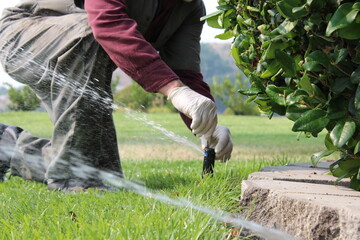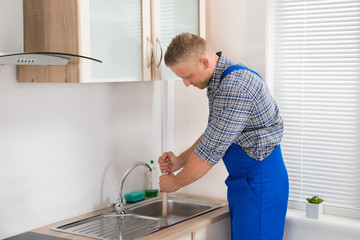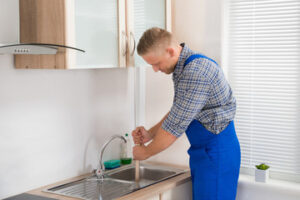
San Jose Cabinet Refinishing is one of the best ways to give your kitchen a fresh new look on a budget. However, there is a lot of conflicting information and advice out there about whether or not it’s necessary to sand cabinets before painting them.
A deglosser will work instead of sandpaper in most cases. It will roughen up the existing surface, remove any gloss and better prep the cabinet for primer and paint.
1. It’s Cheaper
If you’re considering repainting your cabinets, you should be aware that sanding them is essential for a smooth, professional-looking paint job. It may be tempting to skip this step to save time, but doing so can have major consequences on the quality of your finish.
One of the biggest problems caused by not sanding cabinets is poor paint adhesion. This happens because the paint doesn’t have a chance to grip the cabinet surface. Eventually, this can lead to peeling and chipping.
Another common problem is that the new paint won’t cover the existing stain properly. This can create a patchy, uneven look that will be very noticeable.
Finally, if you’re painting over a glossy finish or other surface that’s not a natural wood color, you will probably need to sand before starting. This will roughen up the surface and open up the pores, allowing the primer to adhere better.
The sanding process can be done with a hand sander or power sander. Start with a coarse grit, such as 80 or 100, and work your way up to finer grits (120 or 220). A sanding sponge can also be used to help you get into corners or other hard-to-reach areas. After sanding, wipe down the surfaces with a damp cloth or sponge and allow them to dry completely before proceeding to the next step.
2. It’s Faster
Painting kitchen cabinets is a great way to revamp an outdated or tired looking kitchen and breathe new life into the space. However, if you’re going to go through the trouble of repainting your cabinets, it’s important that you take the time to properly prep and prepare them for paint. This includes sanding. If you skip this step, your new coat of paint may not adhere well and it could begin peeling within a few months.
Skipping sanding before painting can lead to uneven surfaces and bumps that will be visible through the final coat of paint. This can detract from the overall look of your finished project and give it a less polished, professional appearance. Sanding the surface of your cabinetry provides a smooth canvas that will allow your paint to cover evenly and smoothly, resulting in a more refined appearance.
To sand your cabinets, start with a coarse grit such as 120 or 150 grit sandpaper to rough up the surface and remove any old paint. Once the surface is roughed up, switch to a medium grit to remove any remaining fine scratches or marks that have been caused by wear and tear. Finally, use a fine grit such as 220-grit to lighten and smooth the surface of your cabinets before moving on to the priming and painting stages of your project.
If you’re working on a large project, it may be helpful to invest in an orbital sander to help speed up the process. It’s also a good idea to keep several different sandpaper grits on hand so that you can work through the entire process of sanding and priming in the fastest and most efficient manner possible.
3. It’s Easier
If you’re repainting a room, sanding is often part of the prep process. When repairing drywall before painting, for example, you’ll likely need to sand the patch to ensure it adheres properly and blends with the rest of the wall. Sanding is a common step in the paint prep process, as it helps create a smooth surface for primer and paint to cling to, and it can improve the overall quality of the finish.
The first step in sanding cabinets is to remove all hardware, including handles and hinges. This will make it easier to access and sand the cabinets evenly. Next, clean the cabinets with warm water and dish soap or a stronger solution such as TSP (trisodium phosphate) in a well-ventilated area. This will help break down any grease and grime that may have built up on the surfaces of the cabinets and will also help you determine which grit sandpaper to use.
Once the cabinets are clean, you can begin sanding them using 120-grit sandpaper with either a hand or power sander. It’s important to sand in the direction of the grain to avoid creating visible scratches or marks that will show through once the cabinets are painted. Once you’ve sanded the entire surface, switch to a finer grit sandpaper and smooth out any imperfections or bumps to create an even, smooth surface.
Painting your cabinets is an easy and cost-effective way to refresh your kitchen and breathe new life into your home. But if you want your new coat of paint to look its best, it’s essential that you take the time to sand them and prepare them for primer and paint. Skipping this step can cause problems with the adhesion of the new coat and lead to an uneven or unprofessional appearance.
4. It’s More Durable
Painting cabinets is a great way to refresh them and give them a more refined look, but it’s not always a good idea to skip the sanding step. Sanding ensures that the surface of the cabinet is smooth and paint-ready, and it also helps to hide any nicks or scratches that may be visible through a fresh coat of paint. In fact, skipping this crucial prep can lead to a disappointing project and a lackluster appearance.
When you sand the cabinets, you’re creating a microscopically rough surface that helps the new coat of paint to adhere to it more effectively. Without this, the paint could peel or chip over time. By sanding, you can ensure that the new finish will last for a long time.
To sand the cabinets, start by using a mild detergent or degreaser to clean them thoroughly. Make sure to use a damp microfiber rag and dry them completely before moving on to the next step. Then, apply a thin layer of wood sealer or primer to the cabinets to ensure that they’re properly protected and ready for a new coat of paint.
It’s important to use an all-in-one primer, such as DecoArt’s Fresh Start, to avoid having to apply separate layers of both the primer and the paint. After this, sand the cabinets again with a finer grit, such as 120 or 220, to make them smooth and prepped for a new coat of paint. You can also try a sanding sponge instead of a sanding block to make the process easier, as the sponge moulds to the profile of the cabinet front and gets into all the grooves for a silky-smooth finish.
5. It’s Less Expensive
The sanding process makes for a rough surface that helps the primer and paint adhere better, which means your new coats of cabinet paint will last longer. Over time, this will help your cabinets withstand heavy wear and tear from a busy kitchen environment. This also makes the cabinets more attractive, which can make your whole kitchen look refreshed and up to date.
Painting cabinets without sanding is possible, but it’s not ideal. The key to successful painting is proper cleaning, deglossing, and using a quality cabinet paint that’s formulated to stick to wood surfaces. It’s also important to use a brush to get into corners and detailed areas.
Skipping the sanding step will leave you with a cabinet surface full of nicks, scratches, and other imperfections that will show through your new paint coat. This can leave your cabinets with an unfinished, amateurish look and detract from their overall appearance.
Sanding your cabinets may seem like an extra step that’s best left to the professionals, but it can actually save you money in the long run. By hiring a professional to handle the task of sanding and painting your cabinets, you can avoid the added expense of buying new ones and the hassle of trying to do it yourself.
Before you start sanding your cabinets, it’s important to use a tri-sodium phosphate (TSP) cleaner to break down any grease or dirt. This should be done in a well-ventilated area, as TSP is an extremely strong chemical. If you don’t have TSP, a liquid sander/deglosser should work just as well. These are much easier to apply than sandpaper and will prepare the surfaces for paint or stain. It’s also recommended to use a sanding sponge rather than a solid sanding block, as this will be more comfortable and easy on your hands. Lastly, you’ll need to have various sandpaper grits on hand so that you can move from coarse sanding to finer sanding as needed.





